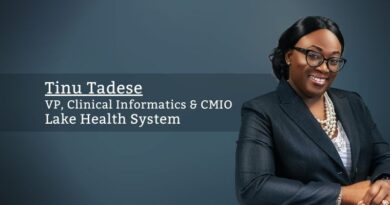Bespoke EHR: Fixing Usability and Physician Burnout One Specialty at a Time
By GQ Zhang, VP & Chief Data Scientist, The University of Texas Health Science Center at Houston (UTHealth)
Physician Burnout
Physician or clinician burnout, perhaps an underestimated and unintended consequence of the 2009 HITECH Act, negatively impacts patient care, clinician caregiver’s well-being and the healthcare system’s viability. The burnout extent may be significantly worse than anticipated, reaching epidemic levels. Consequently, this topic has attracted much attention from healthcare leaders, the biomedical informatics community, the IT sector, and policymakers. Many studies have contributed physician burnout to the burden of interacting with EHR. Increasing percentages of physicians’ time and effort are not spent with the patient they care. Instead, it is being spent on EHR computer screens that are mostly mirroring the traditional paper-based mode of interaction. Efforts to enhance EHR usability to make EHR interfaces more intuitive and more supportive of patient-care workflow have only achieved limited success, if any.
Physician burnout is a complex problem, as many underlying drivers need to be untangled and addressed. “In every crisis lies opportunity,” as the saying goes. Biomedical Informatics and Health IT communities such as AMIA and HIMSS are best positioned to address this crisis, from the technology, policy, caregiver, and carereceiver sides. In this perspective, I offer a possible technology ecosystem pathway (ideally leading to disruption in the end) by fixing EHR one specialty (or subspecialty) at a time. A common, measurable EHR usability metric is needed in the process to make EHR usage burdens (or the lack thereof) more transparent despite the apparent sector-dominance by proprietary systems.
Physician burnout is a complex problem, as many underlying drivers need to be untangled and addressed.
Bespoke EHR: Fixing One (Sub)Specialty at a Time
A Harvard Business Review article published in 2000 indicated that “Healthcare may be the most entrenched, change-averse industry in the United States. The innovations that will eventually turn it around are ready, in some cases, but they can’t find backers.” This is particularly true in Health IT. HIMSS 2018 featured a keynote by Eric Schmidt, who laid out a vision shared among many biomedical informaticians, for transitioning to a better digitally connected health future. This future consisted of not just one killer app but a system of them working together. It will be workflow-based and tailored to the practice medicine, rather than documenting care or issuing billing. AMIA thought leaders recently set an ambitious goal of reducing the documentation burden on U.S. clinicians to 25% by 2025. The expectations are high, but solutions remain few.
Specialty-specific EHRs have been around for a long time, such as those for optometry and orthodontics (perhaps a reason why we do not hear burnout cry from those areas). In other medical specialties, especially those often covered in burnout studies, specialty-specific EHRs are often not seen.
At the University of Texas Health Science Center at Houston (UTHealth), we have designed and implemented EpiToMe – Epilepsy Tracking and optimized Management engine as an exemplar bespoke approach to EHR for epilepsy care. Our approach to bespoke EHR comes with this set of guiding principles called PRSiVILL (pronounced “persevere”):
- P – It should involve Physicians in the design of EHR workflow and interfaces from inception to adoption and operation;
- R – It should Reduce documentation effort and improve EHR usability, mitigating issues that may have contributed to burnout;
- Si – It should focus on a Single subspecialty or specialty with an established patient care workflow;
- V- It should add Value to patient care, research, education, administration, and management;
- I – It should seamlessly Interoperate with the parent, general-purpose EHR system without redundant data entry or double documentation effort;
- L – It should be created de novo Leveraging what the latest computer science and technology can offer, without legacy constraint;
- L – It should help the healthcare system or academic medical center to achieve the goal of a “Learning healthcare system” by creating a readily reusable digital footprint of high-quality data in the process of documenting care.
Since February 2019, 21,456 electroencephalogram reports, 4,534 Epilepsy Monitoring Unit daily reports, and 2,635 Epilepsy Monitoring Unit phase reports have been completed in EpiToMe for 8,939 unique patients. A 10-question survey was completed by 11 (among 16 invited) senior clinical attending physicians. Consensus was found that EpiToMe eased the care documentation burden, a contributor to physician burnout.
Anecdotally, EpiToMe reduced the number of clicks involved in billing at the end of the day from over 20 clicks to about 3. Further details on the design and preliminary evaluation of EpiToMe can be found in a paper recently published in the Journal of Medical Internet Research.
EpiToMe is a part of our general strategy to innovate EHR one specialty at a time. Our approach leverages a number of unique, reusable technological and interface design innovations. This approach is also consistent with the vision of a digital ecosystem of all kinds of apps working together. It minimizes the risk of adversely impacting quality or access to care in specialties not affected, as it reflects our strategy of fixing one specialty at a time, and does not require an overhaul of the parent EHR.
Usability: In Need of a Common Metric
If usability is a contributor to the satisfaction of EHR adoption, then a metric or metrics are needed for assessment and evaluation. According to ISO 9241-11, usability is defined in terms of effectiveness, efficiency, and satisfaction in a particular context of use. For EHR, the context of use is patient care. Assessing EHR usability in patient care would provide critical data to understand the extent of the documentation burden. There are two challenges: one is that most healthcare systems use one of the two proprietary platforms without the freedom of publishing screenshots for case analysis. The second is that, in cases of bespoke EHRs, timely assessment of usability, even on a smaller scale (compared to crowdsourcing) and with limitations, provides valuable and much-needed operational feedback to inform future direction and adoption decisions. Quantitative, comparative usability evaluation between legacy EHR and bespoke EHR, on a collection of common domain-specific tasks arising from patient care, would be most insightful. One such common metric, albeit measuring efficiency only, would be the total “number of clicks” or the number of basic units of action (refined based on user’s cognitive load) needed to complete a patient care documentation task. Such a metric has the advantage of broad applicability because it can handle proprietary systems without revealing intellectual property (regarding interface design). Perhaps this is also one way to measure how U.S. clinicians can reduce documentation effort to 25% by 2025.



